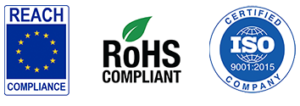Choosing the best adhesive for a specific application can be complex. Many engineers and R&D teams face the question, what kind of adhesive should we choose? There are many variables to be considered and numerous types of chemistries with different capabilities. An understanding of the following parameters will help to narrow the choices. Selecting the correct adhesive will reduce the number of products to be evaluated and increase the likelihood of success. Below is essential information one needs before knowing how to select a high tech adhesive.
1. Substrates: Knowing the materials to be bonded is very important. Certain adhesives may adhere better to ceramic or glass. “Metal” and “Plastic” are generic terms which encompass many different types of materials so knowing the exact substrate is essential for determining the correct adhesive. For example, ABS and Teflon are both plastics, but Teflon requires an acid etch to achieve a bond where ABS can usually be bonded with just an alcohol cleaning. Aluminum is generally easy to bond to with proper preparation however anodized aluminum is universally very difficult to bond to so it is important to know exactly what you are trying to bond.
2. Preparation of Substrates: Most adhesives require that the substrates be prepared properly. Whether it’s just a simple cleaning, or the ability to do more complex operations (such as abrasion, chemical etch or plasma treatment) will all come to play in selecting an adhesive. Any intermediary between the adhesive and the substrate, whether it be dust/dirt, oils, solvents, etc., will decrease bond strength leading to higher rates of failure.
3. Viscosity (Rheology): The viscosity must be considered when choosing the right adhesive. Low viscosity (thin) products are best for thin bonds or applications requiring wicking. Thixotropic materials (won’t run) are best for use in vertical applications or applications where the material must remain on the part even in the presence of heat.
4. Thermal cure vs. UV cure: UV cure adhesives are usually one part and can be cured quickly. They must be exposed to UV light to cure so at least one of the substrates must allow transmission of UV. Thermal cure materials can be cured at room temperature and/or with heat. Heat cured, thermal adhesives can require high temperatures which might be detrimental to components but, in general, they will cure faster with higher properties.
5. Working life: Determine how much work life is desired. Remember that working life (time before the material gels) is generally related to curing time. For thermal cure materials, the longer the working life usually means a longer cure time (at room temperature). Single part UV cured materials can be cured quickly, and the working life doesn’t apply. One part epoxy adhesives, for example, generally do not have a work life as they are room temperature stable for months. However, when exposed to elevated temperatures, it will begin to react.
6. Configuration: The dimensions of the parts and how they fit together are very important to determining the best material. Larger parts and thicker bond gaps may require a slower cure to reduce shrinkage. Certain adhesives are designed to work best with thinner gaps.
7. Required Performance: Some factors that should be understood before selecting an adhesive:
- Does the adhesive need to form a structural bond?
- How much stress will be on the bond during use?
- Will any stresses be consistent or intermittent?
- What optical or aesthetic properties (if any) are important?
- What is the maximum temperature during use? During processing?
- Will there be any excessive humidity during use or testing?
- Will the parts be temperature cycled? And if so, what are the maximum, minimum temperatures and duration?
These are some of the more important issues although for any specific applications there can be other considerations before selecting the right candidate. It is not often feasible to know all the required parameters before choosing, but it is important to have as much information as possible to make an educated decision. There is no substitute for sampling and evaluating a product. Testing often reveals previously unconsidered parameters.
Speaking to experts is always useful. At Epoxyset, we encourage you to speak with our technical team to assist in choosing the best adhesive for your application.
Read an expanded version of this topic and article at Design News online


